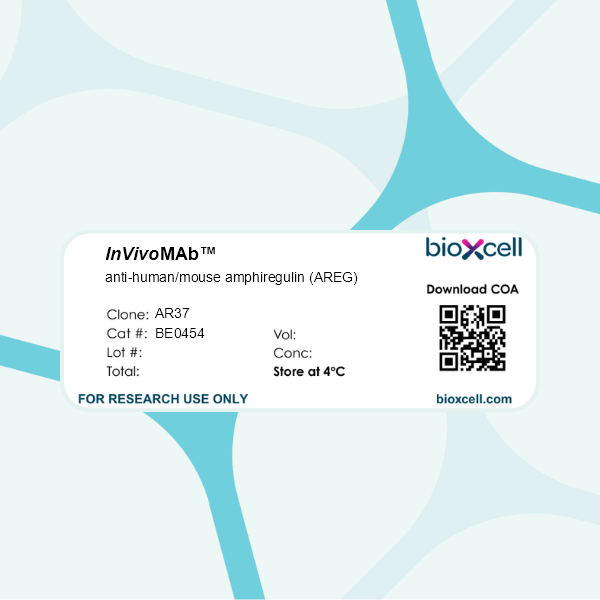InVivoMAb anti-human/mouse amphiregulin (AREG)
Product Description
Specifications
| Isotype | Mouse IgG1, λ |
|---|---|
| Recommended Isotype Control(s) | InVivoMAb polyclonal mouse IgG |
| Recommended Dilution Buffer | InVivoPure pH 7.0 Dilution Buffer |
| Immunogen | Human amphiregulin |
| Reported Applications |
in vivo blocking of amphiregulin (AREG) in vitro blocking of amphiregulin (AREG) Immunofluorescence Western blot ELISA |
| Formulation |
PBS, pH 7.0 Contains no stabilizers or preservatives |
| Endotoxin |
≤1EU/mg (≤0.001EU/μg) Determined by LAL assay |
| Purity |
≥95% Determined by SDS-PAGE |
| Sterility | 0.2 µm filtration |
| Production | Purified from cell culture supernatant in an animal-free facility |
| Purification | Protein G |
| Molecular Weight | 150 kDa |
| Storage | The antibody solution should be stored at the stock concentration at 4°C. Do not freeze. |
| Need a Custom Formulation? | See All Antibody Customization Options |
Application References
in vivo blocking of amphiregulin (AREG)
in vitro blocking of amphiregulin (AREG)
Western Blot
Immunofluorescence
ELISA
Lindzen M, Ghosh S, Noronha A, Drago D, Nataraj NB, Leitner O, Carvalho S, Zmora E, Sapoznik S, Shany KB, Levanon K, Aderka D, Ramírez BS, Dahlhoff M, McNeish I, Yarden Y (2021). "Targeting autocrine amphiregulin robustly and reproducibly inhibits ov
PubMed
Ovarian cancer (OvCA) remains one of the most devastating malignancies, but treatment options are still limited. We report that amphiregulin (AREG) can serve as an effective and safe pharmacological target in a syngeneic murine model. AREG is highly abundant in abdominal fluids of patients with advanced OvCa. In immunocompetent animals, depletion or overexpression of AREG respectively prolonged or shortened animal survival. A new antibody we generated in AREG-knockout mice recognized murine AREG and reproducibly prolonged animal survival in the syngeneic model. The underlying mechanism likely involves binding of wildtype p53 to AREG's promoter and autocrine activation of the epidermal growth factor receptor (EGFR), a step blocked by the antibody. Accordingly, depletion of p53 downregulated AREG secretion and conferred tolerance, whereas blocking an adaptive process involving CXCL1, which transactivates EGFR, might increase therapeutic efficacy. Consistent with these observations, analysis of OvCa patients revealed that high AREG correlates with poor prognosis of patients expressing wildtype TP53. In conclusion, clinical tests of the novel antibody are warranted; high AREG, normal TP53, and reduced CXCL1 activity might identify patients with OvCa who may derive therapeutic benefit.
in vivo blocking of amphiregulin (AREG)
in vitro blocking of amphiregulin (AREG)
Rivera-Soto R, Henley B, Pulgar MA, Lehman SL, Gupta H, Perez-Vale KZ, Weindorfer M, Vijayaraghavan S, Yao TS, Laquerre S, Moores SL (2024). "Amivantamab efficacy in wild-type EGFR NSCLC tumors correlates with levels of ligand expression" NPJ Precis
PubMed
Amivantamab is an FDA-approved bispecific antibody targeting EGF and Met receptors, with clinical activity against EGFR mutant non-small cell lung cancer (NSCLC). Amivantamab efficacy has been demonstrated to be linked to three mechanisms of action (MOA): immune cell-mediated killing, receptor internalization and degradation, and inhibition of ligand binding to both EGFR and Met receptors. Among the EGFR ligands, we demonstrated that amphiregulin (AREG) is highly expressed in wild-type (WT) EGFR (EGFRWT) NSCLC primary tumors, with significantly higher circulating protein levels in NSCLC patients than in healthy volunteers. Treatment of AREG-stimulated EGFRWT cells/tumors with amivantamab or with an AREG-targeting antibody inhibited ligand-induced signaling and cell/tumor proliferation/growth. Across 11 EGFRWT NSCLC patient-derived xenograft models, amivantamab efficacy correlated with AREG RNA levels. Interestingly, in these models, amivantamab anti-tumor activity was independent of Fc engagement with immune cells, suggesting that, in this context, the ligand-blocking function is sufficient for amivantamab maximal efficacy. Finally, we demonstrated that in lung adenocarcinoma patients, high expression of AREG and EGFR mutations were mutually exclusive. In conclusion, these data 1) highlight EGFR ligand AREG as a driver of tumor growth in some EGFRWT NSCLC models, 2) illustrate the preclinical efficacy of amivantamab in ligand-driven EGFRWT NSCLC, and 3) identify AREG as a potential predictive biomarker for amivantamab activity in EGFRWT NSCLC.

